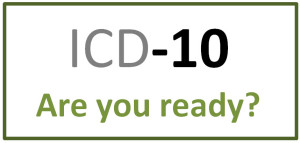By Rose O. Sherman, EdD, RN, FAAN
 If you work in a healthcare organization in the United States today, you are probably hearing a great deal about the implementation of ICD-10 diagnostic codes which will be required for reimbursement effective October 1st, 2015. ICD stands for the International Classification of Diseases developed by the World Health Organization and used globally. ICD-10 represents the first major revision to diagnostic coding since ICD 9 was implemented 30 years ago. The US is actually one of the last countries in the world to upgrade to ICD-10 coding. The change to the new system is mandatory for the healthcare payment of patients treated on or after October 1st of the year. The implementation was initially planned for two years ago but there are significant differences in the coding systems and more transition was needed. What most nurses may not realize is the significant impact that the changes will have on nursing in the area of documentation.
If you work in a healthcare organization in the United States today, you are probably hearing a great deal about the implementation of ICD-10 diagnostic codes which will be required for reimbursement effective October 1st, 2015. ICD stands for the International Classification of Diseases developed by the World Health Organization and used globally. ICD-10 represents the first major revision to diagnostic coding since ICD 9 was implemented 30 years ago. The US is actually one of the last countries in the world to upgrade to ICD-10 coding. The change to the new system is mandatory for the healthcare payment of patients treated on or after October 1st of the year. The implementation was initially planned for two years ago but there are significant differences in the coding systems and more transition was needed. What most nurses may not realize is the significant impact that the changes will have on nursing in the area of documentation.
What is Different about ICD-10
ICD-10 increases the number of diagnostic and procedure codes from the 13,000 in the current ICD-9 system to 68,000 with the new system. The codes themselves change from 3-5 decimal points to 3-7 characters in an alpha-numeric combination. The goal in increasing the number of codes is to provide much more specificity about the patient problems and treatment by including specific terminology about location, laterality (side of body affected) severity, phase of the encounter (acute phase or subsequent encounter). The challenge for all clinical providers will be the level of detail that is needed in the patient’s record to support the coding that will be needed for full reimbursement. The coding of pressure ulcers is a good example. Under ICD-9, there were 9 codes for pressure ulcers. With ICD-10, there will be 125 available codes. The coders in health systems will be charged with the responsibility of analyzing clinical documentation and capturing as many of the codes as are appropriate for an individual patient.
What Will Change with Documentation
Healthcare systems are already making changes to their electronic documentation systems to address the type of information that will be needed to properly code patient care. Patient injuries at home are a good example to illustrate the level of detail which needs to be captured in emergency department charting. Example: A 70 year old female falls at home in her kitchen after tripping over her cat. She complains of a possible concussion and a headache. All of the following information (and more) would need to be documented and coded:
- Type of Encounter (first visit for problem or subsequent visit)
- Did patient lose consciousness?
- Are complaints acute or chronic?
- Has she experienced relief from the headache with treatment or is it intractable?
- External cause of accident (there is a code for pet related injury)
- Activity at time of injury
- Location where injury occurred (there is a code for room in the house)
Meeting the Challenge
In a blog on the 16 most absurd ICD-10 codes , Katie William points to why many providers resist the new system. Codes like Z63.1 Problems in relationship with in-laws or R46.1 Bizarre appearance leave clinicians wondering why there is a need for 68,000 codes. On a recent visit to my primary care physician, I spoke with her about the new coding. She said she had not yet received her “just in time” training but would soon. She wondered aloud about how patients were going to feel about some of the codes related to non-compliance with care and personal risk factors which will be reported to their insurance company and placed in their medical record in more explicit way with the new system.
The new system is here to stay and failure to implement it will result in delayed or no reimbursement. The American Health Information Management Association found in a recent survey that 38% of providers thought their revenue would decrease in the new system. What we do know is that more specificity will be needed in documentation including nursing documentation. This comes at a time when nurses are already expressing concern about increased workloads related to regulatory and other performance requirements. It will no doubt be another challenge for nurse leaders but a necessary one to both improve care and lead to better communication across health systems.
Read to Lead
Centers for Medicare and Medicare Website on ICD-10
© emergingrnleader.com 2015


 LinkedIn
LinkedIn Instagram
Instagram